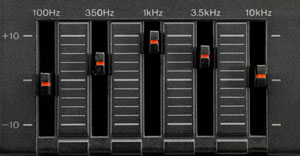Here is a quick, but very cool overview of equalization (EQ). The video (from the WinkSound YouTube Channel) shows you different kinds of EQ and goes over the parameters of each. It also goes over what controls are typically available (bandwidth – sometimes called “Q,” frequency, amplitude, etc.) on different types of EQ units or plugins.
By the way, there are built-in EQ tools in both Audacity and Reaper recording programs, and we show you how to use them in both of our courses in the Newbies Guide To Audio Recording Awesomeness series (TNGTARA 1 uses Audacity and TNGTARA2 uses Reaper).
And without further ado, here is the video:
EQ
Linear Phase and Minimum Phase Equalization
Did you know that not all equalization (EQ) is the same? BTW, if you need a reminder of what EQ is, see our article What is Equalization, Usually Called EQ? Anyway, yeah – usually we work with linear phase EQ. But there is also a thing called minimum-phase equalization. Here is a great article by Samuel O’Sullivan that will explain it all to you.
Read the full thing here: http://www.prosoundweb.com/article/in_the_studio_linear_phase_vs._minimum_phase_eq_includes_video
EQ Tip: Cut Narrow But Boost Wide
 When using EQ to shape you sounds, there are all kinds of words-of-wisdom and rules-of-thumb from the gurus. Some say you should avoid boosting any frequency, but instead focus only on reducing (“cutting”) at target frequencies. Yet another tip is cut (reduce) narrow, boost wide. That means that when you reduce, use only narrow bandwidths but when you turn things up, us wide bandwidths.
When using EQ to shape you sounds, there are all kinds of words-of-wisdom and rules-of-thumb from the gurus. Some say you should avoid boosting any frequency, but instead focus only on reducing (“cutting”) at target frequencies. Yet another tip is cut (reduce) narrow, boost wide. That means that when you reduce, use only narrow bandwidths but when you turn things up, us wide bandwidths.
Here is an article that discusses the merits of that last bit of EQ advice:
http://www.hometracked.com/2008/01/31/eq-cut-narrow-boost-wide/
EQ As The Miracle Solution? What Equalization Can – And Cannot – Do
It is important to understand that use of equalizers (EQ) to enhance audio. This article talks about what EQ can and can’t do. It focuses more on live audio (the site deals with a lot of church performance issues), but the concepts apply to recording as well.
Read the full article here:
EQ As The Miracle Solution? What Equalization Can – And Cannot – Do
Is EQ Really Necessary?
 Someone asked this question over at the Home Recording Forum:
Someone asked this question over at the Home Recording Forum:
If you’re getting the right tone from the start when you record, for example using the tone control on the guitar and its amplifier, why is EQ needed in mixing? I’ve read a bunch of articles singing the praises of EQ, but in the mixes I made I didn’t touch it and they worked fine. I think I only used it once, to round off some top end on a guitar that was annoyingly bright.
Why is it considered so important?
I answered the question with the following:
You’re right about EQ’s necessity if you get the tones right at the source. Ideally it should not be needed, especially if you only have one or two tracks to deal with (say a voice over with some royalty-free music). Many folks over-use EQ to “fix” bad recording techniques. HOWEVER, in music recording, when you have multiple instruments playing together on multiple tracks, things can get muddied up pretty fast. Using EQ to assist in the mixing process becomes very important. The best mixes make room for every element to be heard, and without some EQ, certain instruments tend to mask each other by competing for the same frequencies. One common example is bass guitar and kick drum. They share many of the same frequencies and the best way to let them both be heard more clearly, you have to de-conflict key frequencies, reducing bass in one frequency area (letting the kick through), and reducing the kick in a different area (letting the bass through).
Hopefully that made sense. Basically, the more elements you have in a mix, the more likely you are to need EQ on individual tracks. But if you’re just doing, say, a voice over track, you shouldn’t need any EQ at all if you have a good recording space and decent signal chain.
Cheers!
Ken